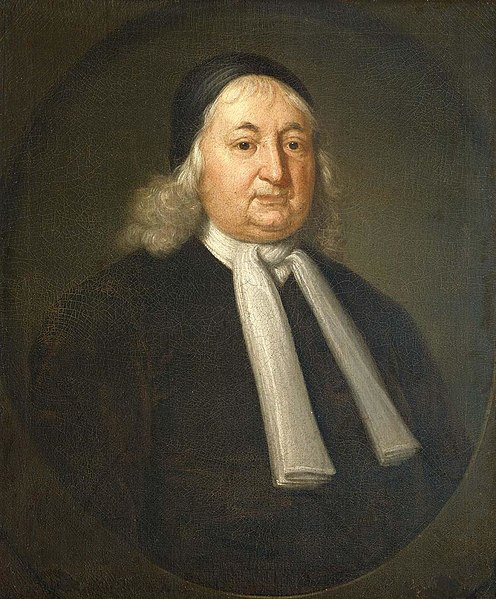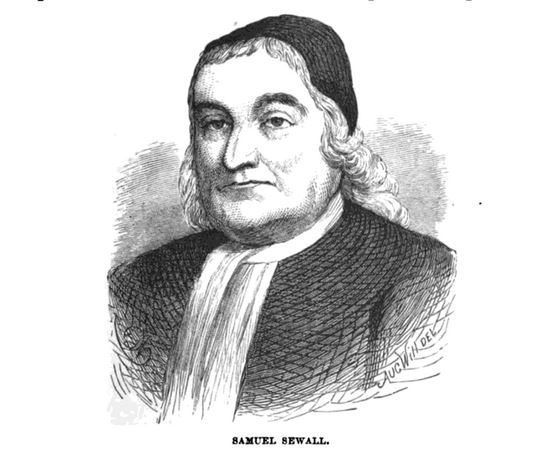Samuel Sewall was a judge in the Salem Witch Trials and the only judge to apologize for his role in the trials.
Sewall was born in Bishopstoke, England on March 28, 1652. His family had previously lived in the settlement of Newbury in the Massachusetts Bay Colony but temporarily returned to England, where Sewall was born. The Sewall family returned to Newbury in Massachusetts in 1661.
Sewall was well educated and attended Harvard University, where he was classmates with Reverend George Burroughs. He graduated in 1671 and then received his master of arts in 1674.
In February of 1676, Sewall married Hannah Hull and joined her father in his silversmith and minting businesses, becoming the mintmaster of the Massachusetts Bay Colony.
Sewall and Hannah Hull had 14 children but only six survived infancy:
John Sewall, born April 2, 1677, died September 11, 1678
Samuel Sewall, born June 11, 1678
Hannah Sewals, born February 3, 1679/80
Elizabeth Sewall, born December 29, 1681
Hull Sewall, born July 8, 1684, died June 18, 1686
Henry Sewall, born December 7, 1685, died December 22, 1685
Stephen Sewall, born January 30, 1686/7, died July 26, 1687
Joseph Sewall, born August 15, 1688
Judith Sewall, born August 13, 1690, died September 21, 1690
Mary Sewall, born October 28, 1691
Jane Sewall, born August 7, 1693, died September 13, 1693
Sarah Sewall, born November 21, 1694, died December 23, 1696
Stillborn son, birthed May 21, 1696
Judith Sewall, born January 2, 1701/2
In 1679, Sewall became a constable and was appointed to the Massachusetts General Court in 1681. He was also appointed by the General Council to run the colony’s printing press, which he did so until 1684.
When Sewall’s father-in-law died in 1683, his wife inherited her father’s fortune which permitted Sewall to shift from business to civic service.
In 1684, Sewall was elected to the Court of Assistants and in 1685 became captain of the South Company of Militia in Boston.
In 1688, Sewall traveled to England with Increase Mather to assist in his efforts to restore the Massachusetts Bay charter of 1629 and to attend to some private business in England.
Sewall returned from England in 1690 and was formally named to the Governor’s Council in 1691.
Samuel Sewall in the Salem Witch Trials:
Sewall was an avid diary keeper but only writes about the Salem Witch Trials a few times in his diary.
The few mentions that he does make though are useful in understanding what it was like to live through them.
Sewall first mentioned the Salem Witch Trials in his diary on April 11, 1692:
“Went to Salem, where, in the meeting-house, was a very great assembly; ’twas awful to see how the afflicted persons were agitated. Mr Noyes prayed at the beginning, and Mr. Higginson concluded” Sewall 358.)
On May 9, 1692, Sewall presided over the examination of his fellow Harvard classmate Reverend George Burroughs but makes no mention of it in his diary.
On May 27, 1692, Governor Phips established the Court of Oyer and Terminer to hear the witchcraft cases and appointed Samuel Sewall as one of the judges on the court.
On August 19, 1692, five convicted witches were hanged in Salem, which Sewall made note of in his diary:
“This day [written in the margin: Doleful Witchcraft] George Burroughs, John Willard, Jn Proctor, Martha Carrier and George Jacobs were executed at Salem, a very great number of spectators being present. Mr. Cotton Mather was there, Mr. Sims, Hale, Noyes, Chiever, & C. Mr. Mather says they all died by a righteous sentence. Mr Burrough by his speech, prayer, protestation of his innocence, did much move unthinking persons, which occasions their speaking hardly concerning his being executed” (Sewall 353.)
A month later, on September 19, 1692, Giles Corey was pressed to death in a field in Salem, which Sewall also noted in his diary:
“Monday, Sept. 19, 1692, About noon, at Salem, Giles Corey was pressed to death for standing mute, much pains was used with him two days, one after another, by the court and Capt. Gardner of Nantucket who had been of his acquaintance: but all in vain.” (Sewall 364.)
Sewall discussed Giles Corey in his diary again the following day:
“Sept. 20. Now I hear from Salem that about 18 years ago, he was suspected to have stamped and pressed a man to death but was cleared. Twas not remembered till Anne Putnam was told of it by said Corey’s spectre the Sabbath day night before the execution” (Sewall 364.)
About a month later in October of 1692, the Court of Oyer and Terminer was dissolved by Governor Phipps which Sewall also noted in his diary:
“Oct. 29. Mr Russell asked whether the Court of Oyer and Terminer should sit, expressing some fear of inconvenience by its fall. Governour said it must fall” (Sewall 368.)
In November of 1692, Sewall was appointed to the Superior Court of Judicature.
Samuel Sewall After the Salem Witch Trials:
On January 14, 1697, the Massachusetts Bay Colony held a day of fasting in honor of the innocent people who were hanged during the Salem Witch Trials.
On that day, Sewall stood in front of the congregation at the South Church in Boston while Reverend Samuel Willard read Sewall’s public apology for his role in the Salem Witch Trials.
The apology read:
“Samuel Sewall, sensible of the reiterated strokes of God upon himself and family, and being sensible, that as to the guilt contracted, upon the opening of the late commission of Oyer and Terminer at Salem (to which the order for this day relates) he is, upon many accounts, more concerned than any that he knows of, desires to take the blame and shame of it, asking pardon of men, and especially desiring prayers that God, who has unlimited authority, would pardon that sin and all his other sins, personal and relative: and according to his infinite benignity, and soveraignty, not visit the sin of him, or any other, upon himself or any of his, nor upon the land: But that he would powerfully defend him against all temptations to sin, for the future, and vouchsafe him the efficacious saving conduct of his word and spirit” (Graham 45.)
Sewall was the only Salem Witch Trials judge to apologize. Many of the people involved in the trials acknowledged that mistakes were made and innocent people were hanged. What prompted Sewall to apologize and not the other judges is not exactly known.
Sewall also published his first book in 1697, which was titled Phaenomena Quaedam Apocalyptica ad Aspectum Novi Orbis Configurata.
In 1700, Sewall published The Selling of Joseph, which was an essay criticizing slavery and was one of the first of its kind.
During his career, Sewall also presided over the trial of several pirates in Boston, such as Jack Quelch, whom he tried and sentenced to death in 1704.
Quelch’s piracy case was considered controversial at the time because Quelch was tried under admiralty law and thus without a jury, which many colonists considered illegal.
Sewall became of a Judge of Probate for Suffolk County in 1715.
In October of 1717, Sewall’s wife Hannah died after a brief illness after which Sewall wrote in his diary:
“God is teaching me a new lesson; to live a widower’s life. Lord help me to learn; and be a sun and shield to me, now so much of my comfort and defense are taken away” (Graham 32.)
In 1718, Sewall became a Chief Justice of the Superior Court of Judicature.
Sewall unsuccessfully courted Katherine Winthrop in 1719 and then remarried later that year, to Abigail Woodmansey Tilley but she died less than six months later in 1720.
In 1721, Sewall published A Memorial Relating to the Kennebeck Indians, which argued in favor of the humane treatment of Native Americans.
Sewall remarried again in 1722, to Mary Gibbs, but still mourned his first wife, Hannah, each year on the anniversary of her death.
In 1725, Sewall declined re-election to the Governor’s Council.
On January 1, 1730, Samuel Sewall died in Boston, Massachusetts at the age of 78 years old.
Sources:
Graham, Judith S. Puritan Family Life: The Diary of Samuel Sewall. Northeastern University Press, 2003.
Sewall, Samuel. The Diary of Samuel Sewall. Vol 2, Massachusetts Historical Society, 1973.
“Samuel Sewall Diaries.” Massachusetts Historical Society, masshist.org/collection-guides/view/fa0243
“Samuel Sewall Takes the Blame and Shame for the Salem Witchcraft Trials.” New England Historical Society, newenglandhistoricalsociety.com/samuel-sewall-takes-blame-shame-salem-witchcraft-trial/


